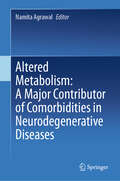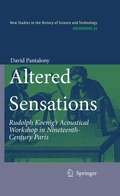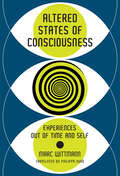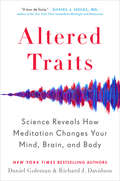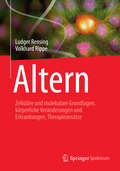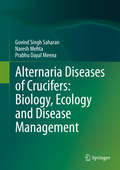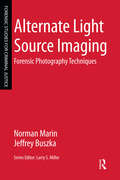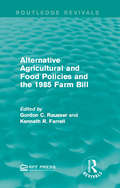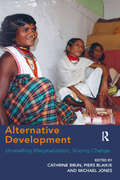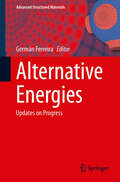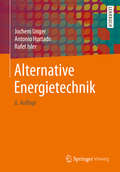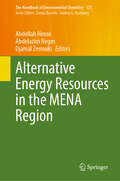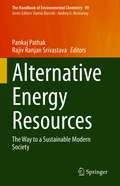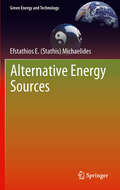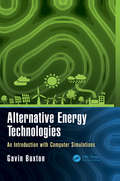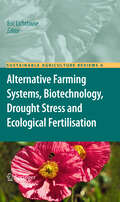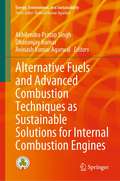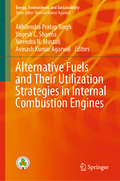- Table View
- List View
Altered Inheritance: CRISPR and the Ethics of Human Genome Editing
by Françoise BaylisWith the advent of CRISPR gene-editing technology, designer babies have become a reality. Françoise Baylis insists that scientists alone cannot decide the terms of this new era in human evolution. Members of the public, with diverse interests and perspectives, must have a role in determining our future as a species.
Altered Metabolism: A Major Contributor of Comorbidities in Neurodegenerative Diseases
by Namita AgrawalThis book presents a systematic and extensive understanding about metabolic alterations affecting multiple aspects of different neurodegenerative diseases (NDDs), such as Alzheimer’s, Parkinson’s, Huntington’s disease, SCAs, SBMA, DRPLA, ALS, Freidrich Ataxia etc. The book also illustrates cellular and molecular mechanisms behind the key neurodegenerative diseases and further expands on concept of unique and developing biomarkers associated with the onset and progression of NDDs. Additionally, it elaborates on the concept of latest imaging tools to monitor state of NDDs and accordingly develop therapeutic approaches entailing phytochemicals in the management of metabolic alterations associated with NDDs that ultimately suppresses course of devastating NDDs. The book aids to improve the overall understanding about the NDD and involvement of metabolic disorder as a major factor for indisposition of the disease. Therefore, suggesting that targetting metabolic variations by phytochemicals can combat NDD related symptoms for the betterment of impacted patients. While introducing cellular and molecular mechanisms and the treatment regimen under the umbrella of metabolism in several NDDs, the book covers major aspects of understanding the metabolic basis of NDDs, its implications, and treatment. This will inflate the readers' understanding about this particular area and guide those working in this domain, be it a researcher or clinicians,to choose or design effective therapeutic strategies to curb metabolic alterations linked with these disorders. This book will not only contribute towards improving the overall state of the challenged individuals but will also bring new hope towards improving the quality of lives of affected patients.
Altered Sensations: Rudolph Koenig’s Acoustical Workshop in Nineteenth-Century Paris (Archimedes #24)
by David PantalonyRudolph Koenig was one of the more prolific and colourful instrument makers in the renowned nineteenth-century precision instrument trade of Paris. Beginning his career as a violin maker, in 1858 the young Prussian immigrant shifted his talents towards the growing field of acoustics. Altered Sensations is a portrait of his vibrant atelier, a place of construction, commerce and experiment. For over forty years it was also a popular meeting place for scientists, artisans, musicians and teachers. Using archival and collection research from across North American and Europe, David Pantalony has traced the material and social influences of this space on the development of modern acoustics. In particular, he has detailed the manner in which Koenig modified, extended, spread and challenged Hermann von Helmholtz's Sensations of Tone. A large part of the research on Koenig comes from the actual products of his workshop which survive in museums and collections around the world. The second section of Altered Sensations provides a Catalogue Raisonné of Koenig's entire line of instruments, including their history, details from specific examples, locations, and references in the literature. This catalogue will serve as a practical guide for curators and researchers as well as a comprehensive overview of nineteenth-century acoustical practice.
Altered States of Consciousness: Experiences Out of Time and Self
by Marc WittmannWhat altered states of consciousness—the dissolution of feelings of time and self—can tell us about the mystery of consciousness. During extraordinary moments of consciousness—shock, meditative states and sudden mystical revelations, out-of-body experiences, or drug intoxication—our senses of time and self are altered; we may even feel time and self dissolving. These experiences have long been ignored by mainstream science, or considered crazy fantasies. Recent research, however, has located the neural underpinnings of these altered states of mind. In this book, neuropsychologist Marc Wittmann shows how experiences that disturb or widen our everyday understanding of the self can help solve the mystery of consciousness. Wittmann explains that the relationship between consciousness of time and consciousness of self is close; in extreme circumstances, the experiences of space and self intensify and weaken together. He considers the emergence of the self in waking life and dreams; how our sense of time is distorted by extreme situations ranging from terror to mystical enlightenment; the experience of the moment; and the loss of time and self in such disorders as depression, schizophrenia, and epilepsy. Dostoyevsky reported godly bliss during epileptic seizures; neurologists are now investigating the phenomenon of the epileptic aura. Wittmann describes new studies of psychedelics that show how the brain builds consciousness of self and time, and discusses pilot programs that use hallucinogens to treat severe depression, anxiety, and addiction.If we want to understand our consciousness, our subjectivity, Wittmann argues, we must not be afraid to break new ground. Studying altered states of consciousness leads us directly to the heart of the matter: time and self, the foundations of consciousness.
Altered Traits: Science Reveals How Meditation Changes Your Mind, Brain And Body
by Daniel Goleman Richard DavidsonTwo New York Times–bestselling authors unveil new research showing what meditation can really do for the brain. In the last twenty years, meditation and mindfulness have gone from being kind of cool to becoming an omnipresent Band-Aid for fixing everything from your weight to your relationship to your achievement level. Unveiling here the kind of cutting-edge research that has made them giants in their fields, Daniel Goleman and Richard Davidson show us the truth about what meditation can really do for us, as well as exactly how to get the most out of it. Sweeping away common misconceptions and neuromythology to open readers’ eyes to the ways data has been distorted to sell mind-training methods, the authors demonstrate that beyond the pleasant states mental exercises can produce, the real payoffs are the lasting personality traits that can result. But short daily doses will not get us to the highest level of lasting positive change—even if we continue for years—without specific additions. More than sheer hours, we need smart practice, including crucial ingredients such as targeted feedback from a master teacher and a more spacious, less attached view of the self, all of which are missing in widespread versions of mind training. The authors also reveal the latest data from Davidson’s own lab that point to a new methodology for developing a broader array of mind-training methods with larger implications for how we can derive the greatest benefits from the practice. Exciting, compelling, and grounded in new research, this is one of those rare books that has the power to change us at the deepest level.
Altered: An Altered Saga Novella (Altered #1)
by Jennifer RushEverything about Anna's life is a secret. Her father works for the Branch, at the helm of its latest project: monitoring and administering treatments to the four genetically altered boys in the lab below their farmhouse. There's Nick, solemn and brooding; Cas, light-hearted and playful; Trev, smart and caring; and Sam . . . who's stolen Anna's heart.When the Branch decides it's time to take the boys, Sam stages an escape. Anna's father pushes her to go with them, making Sam promise to keep her away from the Branch, at all costs. On the run, with her father's warning in her head, Anna begins to doubt everything she thought she knew about herself. She soon discovers that she and Sam are connected in more ways than either of them expected. And if they're both going to survive, they must piece together the clues of their past before the Branch catches up to them and steals it all away.
Altern: Alter und Altern individuell, kollektiv und die Folgen (Schriften der Mathematisch-naturwissenschaftlichen Klasse #27)
by Heinz Häfner Thomas W. Holstein Anthony D. HoWir haben immer mehr Alte, immer weniger Kinder. Dank wissenschaftlicher Fortschritte verlängert sich die Lebenserwartung ständig. Erkenntnisse aus der Naturwissenschaft in der post-genomischen Ära deuten darauf, dass diese Entwicklung trotz der Zunahme altersassoziierter Krankheiten und Behinderungen noch nicht am Ende angekommen ist. Droht diese Flut von Alten, Rentnern und „Konsumenten des Lebens“ zum Verlust des Zusammenhalts der Gesellschaft zu führen? Nach der Bestandsaufnahme der jüngsten Errungenschaften der Forschung hat das interaktive Symposium sich mit den Chancen und Gefahren der „gewonnenen Jahre“ auseinandergesetzt. Die Referentinnen und Referenten sind herausragende Vertreter der Biologie und Medizin. Meinungsbildner der Geisteswissenschaften und Persönlichkeiten aus der Politik kamen ebenfalls zu Wort.
Altern: Zelluläre und molekulare Grundlagen, körperliche Veränderungen und Erkrankungen, Therapieansätze
by Ludger Rensing Volkhard RippeDas für ein breites Publikum geschriebene Werk zeigt die kausalen Verbindungen zwischen den messbaren Alterserscheinungen und den zugrundeliegenden Veränderungen in Genen, Zellen und in deren Kommunikationssystemen auf. Molekularbiologische Ansätze gewinnen in Medizin und Pharmakologie immer mehr an Bedeutung (Molekulare Medizin, targeted therapies, genombasierte personalisierte Medizin), und Kenntnisse über kausale Mechanismen der Alterung werden die Vorsorge und Therapie zahlreicher Alterskrankheiten deutlich verbessern können Die Autoren erläutern diese Zusammenhänge an elf menschlichen Funktionssystemen: Haut, Knochenskelett, Muskulatur, Kreislauf und Lunge, Immunsystem, Verdauungssystem, Ausscheidungssystem, Sexualität und Fortpflanzung, Hormonsystem, zentrales Nervensystem und Sinnesorgane. Jedes Kapitel beginnt mit einer kurzen Übersicht über die normalen Funktionen des Systems; dann werden die altersabhängigen Veränderungen und Erkrankungen mit den zugrundeliegenden molekularen Mechanismen dargestellt. Abschließend gehen die Autoren auf einige medizinische Aspekte von Alterserkrankungen und wichtige therapeutische Ansätze ein. Am Anfang des Buches steht ein einführendes Kapitel über die grundlegenden (evolutions)biologischen Fragen zu Alterungsvorgängen, gefolgt von einer Übersicht über den gegenwärtigen Stand der Altersforschung und die wichtigsten Alterstheorien, darunter die Theorie der Schadensakkumulation und die Theorie der Verkürzung der Chromosomenenden (Telomere) Im letzten Kapitel des Werkes geht es schließlich um die Frage, wodurch die Korrelation zwischen Alter und dem Auftreten der meisten Krebstypen zustande kommt und welche äußeren und inneren Faktoren dabei mitwirken.
Alternaria Diseases of Crucifers: Biology, Ecology and Disease Management
by Govind Singh Saharan Naresh Mehta Prabhu Dayal MeenaThis book deals with the various aspects viz. , the disease, geographical distribution, symptoms on different hosts, host range, yield losses, and disease assessment method, while detailed description on pathogen include taxonomic position, phylogeny, variability, sporulation, perpetuation, and spore germination, host-parasite interactions in the form of seed infection, disease cycle, process of infection, and pathogenesis, epidemiology, forecasting, fine structures, biochemical changes, and phytotoxins, host defence mechanism, techniques to study host-parasite relationships, and management practices including cultural, chemical, biological control practices, and deployment of host resistance. The last section deals with gaps in our understanding, and knowledge about management of these diseases, techniques for the diagnosis of disease and offer suggestions for future research priorities. Each aspect has been vividly illustrated with photographs, histograms, figures, tables, electron micrographs for stimulating, effective and easy reading and understanding. We are sure that this comprehensive encyclopaedic treatise on "Alternaria diseases of crucifers" will be of immense use to the researchers, teachers, students and all others who are interested in the diagnosis and management of Alternaria diseases of crucifers world over. Four species of Alternaria are wide spread and most devastating on cruciferous oil yielding crops, vegetables, forage crops, ornamental plants, and numerous weeds all over the world. The damage to the plants is in the form of infections on seed in the soil during sowing, on seedlings during emergence and growth, on stem, leaves, inflorescence, pods and finally to the seed causing yield losses in seed quantity and quality.
Alternate Light Source Imaging: Forensic Photography Techniques
by Norman Marin Jeffrey BuszkaAlternate Light Source Imaging provides a brief guide to digital imaging using reflected infrared and ultraviolet radiation for crime scene photographers. Clear and concise instruction illustrates how to accomplish good photographs in a variety of forensic situations. It demonstrates how tunable wavelength light sources and digital imaging techniques can be used to successfully locate and document physical evidence at the crime scene, in the morgue, or in the laboratory. The scientific principles that make this type of photography possible are described, followed by the basic steps that can be utilized to capture high quality evidentiary photographs.
Alternating Current (AC) Heating for Lithium-Ion Batteries in Electric Vehicles: Heating Principles, Modeling, and Implementation
by Jiangong Zhu Ranjun Huang Haifeng DaiThis book provides a comprehensive and innovative exploration of low-temperature AC heating techniques for lithium-ion batteries, addressing a critical challenge in electric vehicle (EV) performance. By integrating theoretical insights, experimental validations, and advanced modeling approaches, it offers a systematic framework to understand and optimize battery heating under cold conditions. The book introduces novel methodologies, such as square wave AC heating and impedance-based thermal analysis, which significantly enhance heating efficiency while mitigating degradation risks like lithium plating. With a focus on practical implementation, it also presents cutting-edge solutions for AC heating system design, including integrated charger and self-heating battery pack configurations.The intended readership includes researchers, engineers, and industry professionals in the fields of battery technology, electric vehicles, and thermal management systems. Written at an advanced level, the book bridges the gap between academic research and industrial applications, making it a valuable resource for both theoretical understanding and practical innovation.
Alternative Agricultural and Food Policies and the 1985 Farm Bill (Routledge Revivals)
by Gordon C. Rausser and Kenneth R. FarrellIn 1985, the U.S. Congress confronted the difficult and complex task of developing a 5-year omnibus legislation allowing for lower commodity prices. But, policies predicated on the concept of agriculture as a unique sector of the economy became less and less appropriate to the highly interdependent, open agricultural economy throughout the 1980s. First published in 1985, this collection of 16 papers and related discussions contained in these proceedings is an important contribution toward understanding the issues, options, and dilemmas in U.S. agricultural policy. This is an ideal title for students interested in environmental studies, agriculture, and national policy.
Alternative Arrangements for Marine Fisheries: An Overview (Routledge Revivals)
by Francis T. Christy, Jr.The maintenance of the freedom of fishing in the face of the changing circumstances that were occurring at the time of this title’s original publication in 1973 had produced several damaging consequences. It had led to considerable waste, in both biological and economic terms, and had been the source of increasing conflict. This waste can only be prevented by the adoption of management measures and by the removal of the condition of free and open access. This book explores various techniques for this, and will be of interest to students of environmental management.
Alternative Development: Unravelling Marginalization, Voicing Change
by Piers Blaikie Cathrine BrunThis book brings together a collection of essays that discuss alternative development and its relevance for local/global processes of marginalization and change in the Global South. Alternative development questions who the producers of development knowledges and practices are, and aims at decentring development and geographical knowledge from the Anglo-American centre and the Global North. It involves resistance to dominant political-economic processes in order to further the possibilities for non-exploitative and just forms of development. By discussing how to unravel marginalization and voice change through alternative methods, actors and concepts, the book provides useful guidance on understanding the relationship between theory and practice. The main strength of the book is that it calls for a central role for alternative development in the current development discourse, most notably related to justice, rights, globalization, forced migration, conflict and climate change. The book provides new ways of engaging with alternative development thinking and making development alternatives relevant.
Alternative Ecological Risk Assessment: An Innovative Approach to Understanding Ecological Assessments for Contaminated Sites
by Lawrence V. TannenbaumIn Alternative Ecological Risk Assessment the author, Lawrence V. Tannenbaum, provides a critical review of current practices in the ecological risk assessment field and proposes alternatives that are supported by established science and keen observation. It is hoped that this approach will pave the way to a greater understanding of what appropriate and useful ecological assessment for contaminated sites should entail. He demonstrates that in most cases current practices do not provide for an assessment of ecological risk, and moreover, that endeavoring to assess ecological risk is actually an unnecessary undertaking at conventional hazardous waste sites. (He states, for example, that the concept of scale is often ignored by practitioners, questions why animals like deer are routinely assessed at 5-acre sites, and challenges the ecotoxicology data currently used.) The book is aimed at students and professionals in the fields of environmental science, ecology, ecotoxicology, and health risk assessment.
Alternative Energies: Updates on Progress (Advanced Structured Materials #34)
by Germán FerreiraThis book presents nine chapters based on fundamental and applied research of alternative energies. At the present time, the challenge is that technology has to come up with solutions that can provide environmentally friendly energy supply options that are able to cover the current world energy demand. Experts around the world are working on these issues for providing new solutions that will break the existing technological barriers. This book aims to address key pillars in the alternative energy field, such as: biomass energy, hydrogen energy, solar energy, wind energy, hydroelectric power, geothermal energy and their environmental implications, with the most updated progress for each pillar. It also includes the life cycle assessment (LCA) and thermoeconomic analysis (TA) as tools for evaluating and optimising environmental and cost subjects. Chapters are organized into fundamental research, applied research and future trends; and written for engineers, academic researches and scientists.
Alternative Energietechnik
by Jochem Unger Antonio Hurtado Rafet IslerDieses Lehrbuch vermittelt die technischen Grundlagen sowie wichtige Auslegungs- und Sicherheitskriterien für konventionelle, nukleare und regenerative Energiesysteme. Es zeigt die Auswirkungen des menschlichen Wirtschaftens, erklärt wie diese zu beurteilen und zu berücksichtigen sind. Es zeigt die möglichen Auswege auf, auch wenn umweltrelevante Entscheidungskriterien prinzipiell nicht quantifizierbar sind. Zusätzlich werden auch gesellschaftspolitische Aspekte angesprochen, die zu einem humanen volkswirtschaftlichen Prozess hinführen, der das ökologische Minimalprinzip gerade vollständig ausschöpft. Die anschauliche Darstellung der Sachverhalte mithilfe einfachster mathematischer Modelle setzt nur elementare Kenntnisse der Mathematik und der jeweils relevanten Fachdisziplinen voraus. Für Vertiefung und Übung sind zahlreiche Aufgaben mit den jeweiligen Lösungswegen beigefügt.
Alternative Energy For Dummies
by Rik DeguntherGet the truth about alternative energy and make it part of your life Want to utilize cleaner, greener types of energy? This plain-English guide clearly explains the popular forms of alternative energy that you can use in your home, your car, and more. Separating myth from fact, this resource explores the current fossil fuel conundrum, the benefits of alternatives, and the energy of the future, such as hydrogen and fuel cell technology. The ABCs of alternative energy - what it is, how it works, and what the real costs are Where we are now - learn where our current energy comes from and how much longer it will last Take the first step - see how energy efficiency and conservation can reduce your reliance on fossil fuels Grasp the alternatives - from nuclear power to geothermal energy to wood burning, understand the benefits that alternative energy can have on the nation Apply alternative fuels to transportation - from biofuels to exotic propulsion to electricity, see how they are best used and how hybrid, all-electric, and fuel cell-powered vehicles work Get a peek into the future - see what the outlook holds for each form of alternative energy discussed Open the book and find: The pros and cons of alternative energy A review of the current world energy economy The problems with fossil fuels, from smog to global warming Advantages of alternative energy Practical results of alternatives you can use in daily life Guidelines for investing in alternative energy vehicles Ten ways you can bring about change right now Insight into the future of energy production - and how you can invest in it
Alternative Energy Resources in the MENA Region (The Handbook of Environmental Chemistry #131)
by Abdelazim Negm Abdellah Henni Djamal ZerroukiThis book outlines the development of renewable energies in the Middle East and North Africa, it offers up-to-date information about their variability, availability and utilization, and serves as a guide for understanding the MENA renewable energy potential. Readers will find an authoritative discussion about the implementation of renewable energies, trends and forecast of solar, wind and geothermal systems applications in this region. Case studies from China, Mexico and Vietnam are also included in this book to foster the implementation of renewable energies in the MENA region. The MENA region is known for its immense oil, petroleum and gas reserve, being one of the most important regions in the world for fossil energy accessibility and, hence, for the global economic stability. This region holds at the same time the world’s greatest potential for renewable energy and over the past few years it has been receiving national and international political support for promoting the future of solar and wind power energies. However, can the region go green taking into account the availability of the natural resources? Expert contributors from countries such as United Arab Emirates, Egypt, Algeria, Turkey, and Morocco provide their perspective on this challenge and offer a comprehensive overview of the latest pilot projects for renewable energy in the region. This book will appeal to researchers, students, engineers and policymakers interested in the potential of alternative energy resources in the MENA region.
Alternative Energy Resources: The Way to a Sustainable Modern Society (The Handbook of Environmental Chemistry #99)
by Pankaj Pathak Rajiv Ranjan SrivastavaThis book reviews alternative and renewable energy resources in order to pave the way for a more sustainable production in the future. A multi-disciplinary team of authors provides a comprehensive overview of current technologies and future trends, including solar technologies, wind energy, hydropower, microbial electrochemical systems and various biomass sources for biofuel production. In addition, the book focuses on solutions for developing countries. Conventional energy sources are finite, and estimates suggest that they will be exhausted within a few decades. Finding a solution to this problem is a global challenge, and developing countries in particular are still highly dependent on fossil fuels due to their rapidly growing populations accompanied by a huge growth in primary energy consumption. Moreover, the most common conventional energy sources (coal and petroleum) are non-sustainable since their combustion exponentially increases greenhouse gas emissions. As such, there is a pressing need for clean energy based on alternative or renewable resources, not only to ensure energy supplies at an affordable price but also to protect the environment.
Alternative Energy Sources (Green Energy and Technology)
by Efstathios E MichaelidesAlternative Energy Sources is designed to give the reader, a clear view of the role each form of alternative energy may play in supplying the energy needs of the human society in the near future (20-50 years). The two first chapters on "energy demand and supply" and "environmental effects," set the tone as to why alternative energy is essential for the future. The third chapter gives the laws of energy conversion processes, as well as the limitations of converting one energy form to another. The section on exergy gives a quantitative background on the capability/potential of each energy source to produce power. The fourth, fifth and sixth chapters are expositions of fission and fusion nuclear energy, the power plants that may produce power from these sources and the issues that will frame the public debate on nuclear energy. The following five chapters include descriptions of the most common renewable energy sources (wind, solar, geothermal, biomass, hydroelectric) some of the less common sources (e.g. tidal and wave energy). The emphasis of these chapters will be on the global potential of each source, the engineering/technical systems that are used in harnessing the potential of each source, the technological developments that will contribute to wider utilization of the sources and environmental effects associated with their wider use. The last three chapters are: "energy storage," which will become an important issue if renewable energy sources are used widely. The fourteen chapters in the book have been chosen so that one may fit a semester University course around this book. At the end of every chapter, there are 10-20 problems and 1-3 suggestions of semester projects that may be assigned to students for further research.
Alternative Energy Technologies: An Introduction with Computer Simulations (Nano and Energy #5)
by Gavin BuxtonAlternative energy sources are becoming increasingly important in a world striving for energy independence, clean air, and a reprieve from global warming. Solar cells, wind power, and biofuels are some of the competing alternative energy sources hoping to gain a foothold in our future energy mix, and the economic advantages of these technologies are continually increasing as costs are reduced and efficiencies increased. Alternative Energy Technologies: An Introduction with Computer Simulations explores the science and engineering behind a number of emerging alternative energy technologies, including polymer solar cells, algae biofuels, and artificial leaves. It also addresses the environmental need for these technologies. However, unlike its predecessors, this book employs simple computer models implemented within spreadsheet environments to simulate different aspects of the alternative energy technologies and therefore teach the subject matter. This unique approach: Provides a dual introduction to alternative energy technologies and computer simulation Elucidates the fundamental behaviors and complex interactions within the alternative energy systems Makes computer simulation straightforward and accessible to readers with no prior programming experience Featuring investigative exercises that deepen understanding and inspire further research, Alternative Energy Technologies: An Introduction with Computer Simulations makes an ideal introductory textbook for undergraduate students and a valuable professional reference for experimental researchers.
Alternative Farming Systems, Biotechnology, Drought Stress and Ecological Fertilisation (Sustainable Agriculture Reviews #6)
by Eric LichtfouseSustainable agriculture is a rapidly growing field aiming at producing food and energy in a sustainable way for our children. This discipline addresses current issues such as climate change, increasing food and fuel prices, starvation, obesity, water pollution, soil erosion, fertility loss, pest control and biodiversity depletion. Novel solutions are proposed based on integrated knowledge from agronomy, soil science, molecular biology, chemistry, toxicology, ecology, economy, philosophy and social sciences. As actual society issues are now intertwined, sustainable agriculture will bring solutions to build a safer world. This book series analyzes current agricultural issues, and proposes alternative solutions, consequently helping all scientists, decision-makers, professors, farmers and politicians wishing to build safe agriculture, energy and food systems for future generations.
Alternative Fuels and Advanced Combustion Techniques as Sustainable Solutions for Internal Combustion Engines (Energy, Environment, and Sustainability)
by Avinash Kumar Agarwal Akhilendra Pratap Singh Dhananjay KumarThis monograph covers different aspects related to utilization of alternative fuels in internal combustion (IC) engines with a focus on biodiesel, dimethyl ether, alcohols, biogas, etc. The focal point of this book is to present engine combustion, performance and emission characteristics of IC engines fueled by these alternative fuels. A section of this book also covers the potential strategies of utilization of these alternative fuels in an energy efficient manner to reduce the harmful pollutants emitted from IC engines. It presents the comparative analysis of different alternative fuels in a variety of engines to show the appropriate alternative fuel for specific types of engines. This book will prove useful for both researchers as well as energy experts and policy makers.
Alternative Fuels and Their Utilization Strategies in Internal Combustion Engines (Energy, Environment, and Sustainability)
by Yogesh C. Sharma Avinash Kumar Agarwal Akhilendra Pratap Singh Nirendra N. MustafiThis book covers alternative fuels and their utilization strategies in internal combustion engines. The main objective of this book is to provide a comprehensive overview of the recent advances in the production and utilization aspects of different types of liquid and gaseous alternative fuels. In the last few years, methanol and DME have gained significant attention of the energy sector, because of their capability to be utilized in different types of engines. This book will be a valuable resource for researchers and practicing engineers alike.

